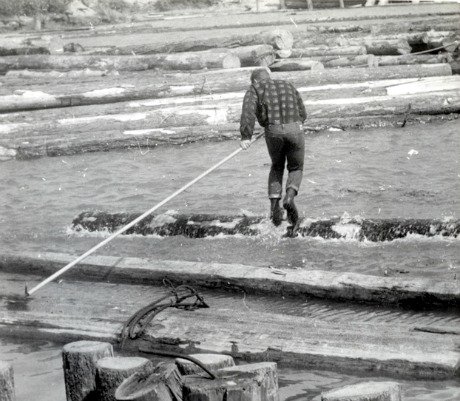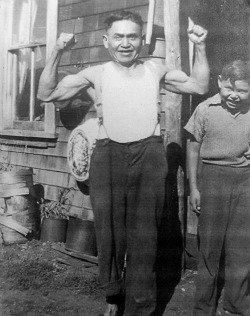
By Eric Andersen
Published: Aug. 4, 2013
The annual Squamish Days Loggers Sports Festival – the largest and the oldest running show, celebrating 56 years this year, in the entire Pacific Northwest – is an occasion to remember the early days of the our timber industry, and the beginnings of Loggers’ Sports itself.
Our local timber industry was pioneered by Easterners, who brought with them their lumberjack and log driving skills, and a culture – which included the pastime of loggers’ sports.
For example, there were the DeBecks, the Barbours and Lambs from New Brunswick; partners S.P. Moody and Moses Ireland from Maine; the Merrills, the Woods, Owen Fulk and Fred Buck from Michigan; and Gustave Courte, recruited by the Squamish Timber Company from Quebec’s Rivière Rouge district – who would tell his grandchildren, “I was once a birling man on the Squamish River!”

But critical for the success of logging during the river driving era were the experienced hand loggers and expert canoe men hired from the local Squamish Nation villages.
Chief Jimmy Jimmy of Skowshin village was hired to organize the freighting of supplies up the river to the camps.
‘Xwa-xwalkn’ – Austin Harry, when interviewed by local newspaper editor Rose Tatlow in the early 1960s remembered his first job, working for the E.K. Wood Lumber Co. 25 miles up the river at the mouth of Ashlu Creek.
“I can recall standing in icy water up to my chest, rolling logs into the river so they would drift down in the current.”
The first properly organized day-long Squamish loggers’ sports competition event took place in 1927, sponsored by the Merrill & Ring railway logging company.
Austin Harry was working for them in their booming grounds, near Sta-mus village. He later worked for Empire Mills for 14 years as a boom-man, and his sons Ernie and George followed after him in this trade.
In the 1930s and 40s Squamish loggers’ sports days were held in a small field at the northwest corner of Victoria and Second Ave. One of the regular competitors back then was Austin Harry.
From the late 1950s, Squamish Loggers’ Sports moved to new grounds where Capilano University campus is today, and the log birling competitions took place in the old East Branch of the river – exactly the scene of the river drives more than a century ago.
The log driving companies’ pilings are still to be seen there today.


Eric Andersen says
Just a correction on the boom-man photo — which should be credited to “Squamish Public Library”. Thanks!